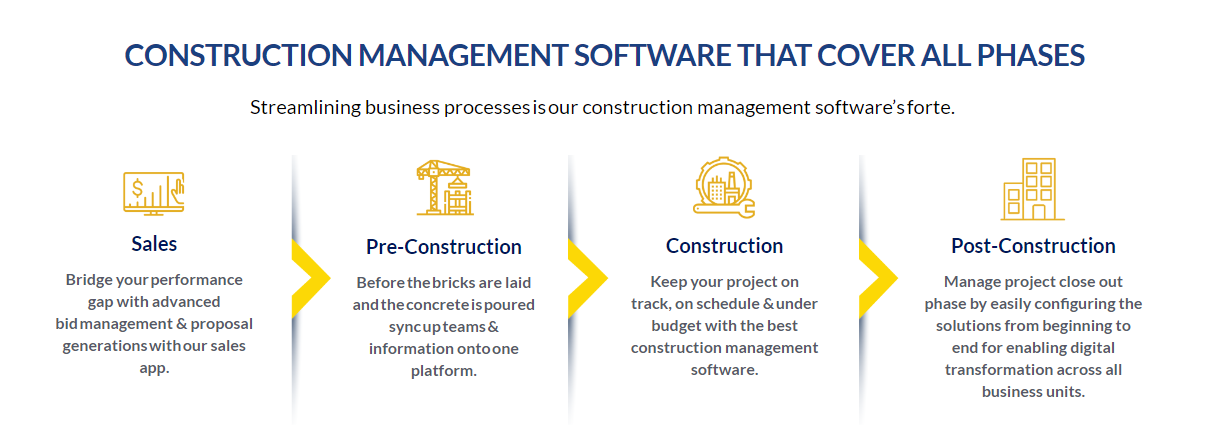
3 Key Tips for successfully Implementing Construction Software
Most construction professionals across the industry are now turning to software solutions to replace the painstaking paper-based, manual or non-automated processes that have held them back for years. Spreadsheets, manual data entry, and management are now things of the past, with implementing construction software becoming the norm. Construction project management is a complex task involving a range of phases, and modules. Therefore, a well-executed process for rolling out the decided construction management software is integral for a smooth and efficient workflow.
However, there are always risks associated with enterprise level developments. With great implementations come great risks – even if a company has effective software, a flawed implementation plan can quickly make things go south! This article will discuss the three key aspects that unlock a successful construction software implementation.
Construction Industry and Tech:
New technology trends can help construction companies save significant time and money. Unfortunately, many of the solutions applied in the construction industry are inefficient, ineffective, and counterproductive. Additionally, there has been a great deal of resistance towards technology in the construction industry. Initiatives to introduce technology, software, and automation have failed due to a lack of acceptance from project stakeholders and resistance from employees. So how do you get your employees onboard?
Business owners often neglect the importance of the entire team. Technological infrastructure is decided at the executive level. This means that the managerial team and the staff are often left out of the discussion. This causes much dissatisfaction in the company and eventually leads to resistance.
Construction companies can address such issues by simply being vocal about upcoming changes and explaining to their staff how the new technology, such as construction management software, can help streamline the overall process. For example, the management can highlight how general contractors and project managers can simplify project management with the software.
What Goes Wrong in Construction Implementations?
A construction management software implementation can go sideways for several reasons. One of the biggest reasons this happens is that organizations do not take the time to define their goals to the vendor. Most businesses turn to construction management software, hoping to solve all their construction process problems. Still, they do not take the time to understand and express what they want to accomplish from the implementation. They do not know how they will measure the success or failure of the implementation and thus end up with a system that is not equipped to meet their needs.
Additionally, construction project owners often fail to provide the construction technology provider ample time to execute the implementation-related tasks properly. They also feel that their teams have to do two jobs at once as they are completing their daily tasks while also spending time understanding the new solution. Consequently, it becomes quite challenging for project owners and managers to navigate such situations, resulting in a demotivated workforce that does not understand the new system in place.
Inadequate training is also one of the main reasons why construction software implementations fail. Most software vendors try to get the system running as quickly as possible and ignore the training requirements. The reason for this is the aggressive timelines and budget restrictions imposed on the implementation. Most companies do not test how the users respond to the software – even if they do, the time allotted to the user acceptance training is very little. Thus, the testing cannot effectively determine how well employees respond to the new software.
Read More about our construction software here:
Successful Implementations with BUILDFitters:
BUILDFitters is a construction management software that integrates all aspects of the construction project. From sales, preconstruction, construction, and close out, BUILDFitters has an array of advanced features that allow for a streamlined workflow, improved processes, and enhanced communication.
As construction management software experts, the BUILDFitters team has provided companies across the globe with customized software solutions. Following a tried and tested methodology, we have successfully implemented the BUILDFitters solution for companies of all sizes and across construction verticals. In our experience, three key components are crucial to a successful software implementation:
1. Deciding on a Plan and Setting Goals:
Construction project owners need to clearly define what they want to get out of the new software implementation. They should take out time to sit with the construction management software provider to discuss their current pain points and how the software can help them overcome them. The timeline of the implementation, possible problem areas, and hiccups should also be addressed in advance so that realistic goals can be set, and a proper plan can be made.
2. Involve your Entire Team:
The construction industry is notoriously known for resistance to ideas that question their familiar ways. Construction project owners need to educate their employees on the importance of new technology and how it can simplify THEIR jobs. Most employees want to work with efficient tools and will likely embrace construction management software if they understand its benefits.
For example, the BUILDFitters app helps field agents easily identify opportunities when they are working on-site. They can easily manage customers and opportunities within a single dashboard from their device. Field agents can create the opportunity after keying in the account, contact, address, and other related information. Eventually, this data can also be used to create a granular breakdown of the cost expenditure through drill-down reporting.
All this can be done with a few clicks of a button instead of filling out piles of paperwork. Furthermore, since this data is saved on the cloud, the field agent can easily share it with relevant stakeholders without communicating back and forth.
3. Provide Proper Training:
Good construction management software is easy to use and understand, but this does not mean the company should neglect training its resources on how to use it. If a company fails to train its employees on the new software, the software will be a waste of investment.
An end-to end construction software such as BUILDFitters, offers dedicated support and training staff that helps companies understand the solution through personalized training on-site and online sessions. Video tutorials, conferences, and on-the-job training are a few ways a construction company can ensure that their employees truly understand how to use construction management software.
Transform Your Construction Management with Our BUILDFItters!
Want to overcome construction management challenges? Let us guide you with our construction project services. Reach out today and unlock the full potential of your projects!
Final Thoughts:
Construction management software is the next step for companies looking to streamline their AEC operations. However, companies must ensure they have the right technology solution and partner for this step. BUILDFitters is a construction management software with a dedicated team that has helped companies across construction verticals to optimize their operations. We have years of experience in implementing and integrating construction software solutions for companies like MBarC, AEC, Voytko Mechanical, and SAFTI FIRST.
FAQ:
Q: How long does it usually take to implement construction management software?
A: The duration of construction management software implementation can vary depending on factors such as the software’s complexity, the organization’s size, and the level of customization required. Typically, implementation can range from a few weeks to several months.
Q: What are some common challenges encountered during the implementation of construction management software?
A: During the implementation process, organizations may face challenges such as resistance from employees, difficulty in data migration, integration issues with existing systems, inadequate training, and ensuring user adoption. It is important to address these challenges proactively to ensure a smooth implementation.
Q: Can construction management software be integrated with other existing software systems used by the company?
A: Yes, many construction management software solutions offer integration capabilities with other software systems commonly used in the construction industry, such as accounting software, project scheduling tools, and document management systems. Integration allows for seamless data exchange and streamlines workflows across different software platforms. It is recommended to check with the software vendor about their integration capabilities and any specific requirements for successful integration.




